MUSIC IN IRAN
MUSIC IN IRAN.- Excerpt from the book “Iran por dentro, la otra historia”
Alfred Gutiérrez-Kavanagh – International Relations Professor (Middle East), UPC – Madrid
© Alfred G. Kavanagh. Article published in his book IRAN POR DENTRO. La otra historia and authorized to be published on this website by the author. Total or partial reproduction of the same without written consent of the author is prohibited.
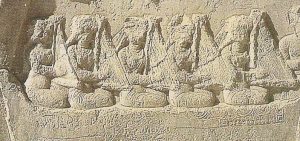
Bas-relief in Tāq-e Bostān. Musicians playing the harp.
Iran has a very rich musical tradition, product of the interaction of very diverse influences, and of its own development and adaptation of styles and instruments that merchants of the Silk Road brought from China and Central Asia on their way to the cities of Asia Minor. More than two thousand years ago, Iran exported lutes and string instruments to the West, as well as the technique of using a bow to play them. In numerous bas-reliefs and clay tablets from the Sumerian and Akkadian civilizations we can find images of musicians with zither and cymbals accompanying the court Bas-relief in Tāq-e Bostān. Musicians playing the harp.. There has been no era or dynasty that has not left us a visual legacy of the importance of music to Iranians throughout all of history. The first thought of any Iranian on his own language is usually, “širine“, that is sweet. In their daily conversation, the Persians introduce endless sayings, puns and rhymes, without any need to establish a rigid distinction between prose and poetry.

The mythical musician Barbad in a concert given before the Sassanid sovereign Cosroes Parviz
In the Persian language, the term musiqi, from the Greek language, mousike, that which comes from the muses, is used exclusively for instrumental music. The verb jāndan, to read, is used both in the sense of reciting and singing. News about the first Persian rhapsodies or bards shows that many of them were equally skilled in the art of singing, reciting and playing some musical instrument, skills that were considered closely related to each other, because musicality is one of the most valued characteristics of the Persian language.
The modal system of Iranian music is based on twelve scales divided into seven major and five minor. Each one of them comprises a variable number of melodic sequences that follow one another according to a predetermined order. These sequences (gušē) form the basis of any composition.
Each mode gives the composer between twenty to forty melodic sequences. Within each scale in turn, there is a root note called šahed that is repeated at certain intervals, notes that indicate a pause, notes that can be modified by the artist, and notes used to conclude the piece. Although there is considerable scope for improvisation, since the musician can use sequences belonging to other scales, he is obliged to respect numerous conventions linked to each tonal system. The training of a musician is based on the knowledge of all the melodic sequences of each modal system until mastering the canon or radif. The systematic organization of the oral transmission of modes and sequences was due to ‘Ali Akbar Farāhāni (1810-1855) the Qāŷār court musician known for his virtuosity with the three-stringed lute (tār).
The literary references and the different artistic manifestations of each of the historical periods of Iran show that the musicians were highly appreciated at the Court and in the halls of the great dignitaries. Some acquired a legendary fame like Barbād, the musician and poet linked to the court of the Sassanid monarch Chosroes II. We have abundant news of the lavish celebrations at the court of the Abbasid caliph, Hārun al-Rašid, whose music teacher Ebrāhim Mowsoli (742-803) was the caliph’s great pride for his unparalleled talent, also inherited by his son Esḥāq Mowsoli (767 -850).
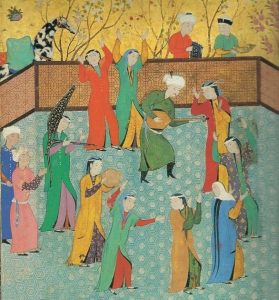 In Islamic times, the translation of classical Greek and Alexandrian works on the divine origin of music had a great influence on the development of Islamic musicology. Some of the main theorists were Persians such as Abu Naşr Fārābi, Avicenna or Qoṭb al-Din Širāzi. Although there is no express prohibition in the Koran regarding music, the moral conservatism of many commentators have seen in this activity an instrument of distraction or perversion that incites the Muslim to other prohibited activities such as adultery or the consumption of alcohol or prohibited substances. In the first centuries of Islam, a clear distinction was made between sacred and profane music. Reading the Persian, historical chronicles show us that despite the efforts of theologians (motekalem) and the censors of morality (moḥtaseb), music was highly appreciated by all sectors of the population and many monarchs spent huge sums in hiring the best musicians for real pleasure (‘eyš).
In Islamic times, the translation of classical Greek and Alexandrian works on the divine origin of music had a great influence on the development of Islamic musicology. Some of the main theorists were Persians such as Abu Naşr Fārābi, Avicenna or Qoṭb al-Din Širāzi. Although there is no express prohibition in the Koran regarding music, the moral conservatism of many commentators have seen in this activity an instrument of distraction or perversion that incites the Muslim to other prohibited activities such as adultery or the consumption of alcohol or prohibited substances. In the first centuries of Islam, a clear distinction was made between sacred and profane music. Reading the Persian, historical chronicles show us that despite the efforts of theologians (motekalem) and the censors of morality (moḥtaseb), music was highly appreciated by all sectors of the population and many monarchs spent huge sums in hiring the best musicians for real pleasure (‘eyš).
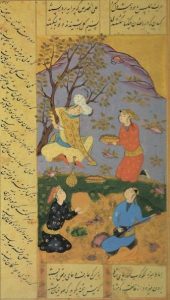 Practically until the beginning of the 20th century, Persian classical music survived through the patronage of the court and of high royal officials who organized private sessions of secular or religious music on the occasion of some celebration or for mere pleasure. Generally, those were small companies of musicians with a family structure that transmitted musical knowledge orally. In times of greater religious intolerance, the censors of morality exercised a strong control and repression of all activities related to music or dance, considering them contrary to morality. According to an ancient Islamic saying, only on the pilgrimage to Mecca can men and women be together in society, but at all other times, except in the privacy of the home, segregation of both sexes should be the norm. After the 1979 Islamic Revolution, women could not sing or dance in public and the reproduction and dissemination of any musical composition containing female voices was prohibited. This restriction caused the exile of great figures of the Iranian traditional song to the United States or Europe, such as the idolized Gugush. The argument used in ultra-conservative Islamic states to prohibit the dissemination of the female voice practically starts from the first theological speculations in Islam that considered that the voice and the very presence of women in public places distract men from their religious duties.
Practically until the beginning of the 20th century, Persian classical music survived through the patronage of the court and of high royal officials who organized private sessions of secular or religious music on the occasion of some celebration or for mere pleasure. Generally, those were small companies of musicians with a family structure that transmitted musical knowledge orally. In times of greater religious intolerance, the censors of morality exercised a strong control and repression of all activities related to music or dance, considering them contrary to morality. According to an ancient Islamic saying, only on the pilgrimage to Mecca can men and women be together in society, but at all other times, except in the privacy of the home, segregation of both sexes should be the norm. After the 1979 Islamic Revolution, women could not sing or dance in public and the reproduction and dissemination of any musical composition containing female voices was prohibited. This restriction caused the exile of great figures of the Iranian traditional song to the United States or Europe, such as the idolized Gugush. The argument used in ultra-conservative Islamic states to prohibit the dissemination of the female voice practically starts from the first theological speculations in Islam that considered that the voice and the very presence of women in public places distract men from their religious duties.
PROFANE MUSIC
“… ei motreb” Countless poems in the Persian language begin with these words, directed to the musician (moṭreb) of the assembly to find some composition of his repertoire that reflects the state of mind of those present who, according to poetic conventions, are absorbed in each of the gestures and movements of the beautiful cupbearer who responds with disdain or impertinence to the requirements of his admirers.
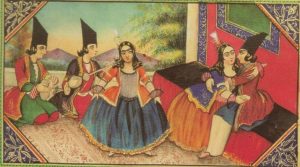
Musicians and dancers of the Qāŷār period
Many musicians came from a social group with a code of honour of their own known for their bravery, generosity and heterodoxy, the Luti. Tumblers, peddlers, strongmen, versifiers, dancers or musicians, with their own jargon and provocative gestures are present in many cities of Iran, being one of the picaresque characters with the greatest presence in Iranian literature. The perception that the population had about those groups, was summarized by Nāṣer Josrow in these verses: In the city of Balj they are of the opinion that to be a poet is to be a drinker, a thief, a luthi and a pregnant woman.
Many traveling musicians were gypsies, called kowli, possibly because many of them came from Kabul. The three large groups of gypsy ethnic groups speak languages of Indo-European origin and the influence of the Persian language is appreciable in many words such as amrol, pear in Romany, which derives from the Persian amrud.
RELIGIOUS / MYSTICAL MUSIC
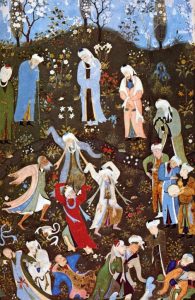 In the chapter dedicated to Persian literature we have been able to verify that the great majority of the works of mystics such as Rumi, ‘Aṭṭār or Sanā’i are composed in verse and from the testimonies of their biographers we know that music played a fundamental role in his mystical raptures. The practice of religious chanting was introduced into Sufism possibly by the mystic Dhu al-Nun Misri towards the 9th century since this Abyssinian, converted to Islam, had been born in Thebaida where there were many monks and communities of hermits that will exert an important influence on the development of Islamic mystical practices. This contemplative mystic was the introducer in the Sufi flow of concepts such as the abodes of the soul, or the doctrine of the stages, or of the mystical stages necessary to cover until reaching the desired union with the Beloved. One of the best studies on these reciprocal influences between Christian and Muslim mysticism corresponds to the great Arabist Miguel Asín Palacios when examining the figure of the Sevillian Ibn-‘Arabi and the repercussion of his work in the East. The assemblies of ecstatic Sufis began by singing some improvised song with allegorical allusions to the rapture and delivery between lovers in order to operate a transmutation in the alchemy of the soul, sensuality and erotic desire become luminous energy for divine union. It will be precisely in the dense mystical treatise of Ibn-‘Arabi, the Fotuhāt al-Makkiya where he meticulously analyses the different ways of manifesting love from mere affection, passing through passion to spiritual love in which the lover only desires the good of the beloved until reaching mystical annihilation, a non-being, not expecting anything but to be able to be unconditionally in the beloved.
In the chapter dedicated to Persian literature we have been able to verify that the great majority of the works of mystics such as Rumi, ‘Aṭṭār or Sanā’i are composed in verse and from the testimonies of their biographers we know that music played a fundamental role in his mystical raptures. The practice of religious chanting was introduced into Sufism possibly by the mystic Dhu al-Nun Misri towards the 9th century since this Abyssinian, converted to Islam, had been born in Thebaida where there were many monks and communities of hermits that will exert an important influence on the development of Islamic mystical practices. This contemplative mystic was the introducer in the Sufi flow of concepts such as the abodes of the soul, or the doctrine of the stages, or of the mystical stages necessary to cover until reaching the desired union with the Beloved. One of the best studies on these reciprocal influences between Christian and Muslim mysticism corresponds to the great Arabist Miguel Asín Palacios when examining the figure of the Sevillian Ibn-‘Arabi and the repercussion of his work in the East. The assemblies of ecstatic Sufis began by singing some improvised song with allegorical allusions to the rapture and delivery between lovers in order to operate a transmutation in the alchemy of the soul, sensuality and erotic desire become luminous energy for divine union. It will be precisely in the dense mystical treatise of Ibn-‘Arabi, the Fotuhāt al-Makkiya where he meticulously analyses the different ways of manifesting love from mere affection, passing through passion to spiritual love in which the lover only desires the good of the beloved until reaching mystical annihilation, a non-being, not expecting anything but to be able to be unconditionally in the beloved.
These assemblies, which in Muslim Spain were well received by the group known as the sadilíes or alumbrados, were widely criticized by the more orthodox theologians such as Ibn ‘Arabi. Many Persian mystics such as Ahmad Ğazāli, Owhād ad-Din Kermāni or ‘Irāqi considered that the best vehicle for the contemplation of divine beauty was the vision of a handsome boy without a beard. Music, religious dance or samā ‘and the presence of beautiful young people in the monastery made it possible to transcend the accidental beauty of creation and immerse oneself in eternal beauty. The second caliph of Islam, Abu Bakr had once said that “al-‘ajzu‘ an darki al-idrāki idrākun “, the inability to perceive the perceived is itself a perception.
TRADITIONAL MUSICAL INSTRUMENTS
Among the stringed instruments used in Iranian classical music, we must highlight the tār, which is a plucked string instrument with a double resonance box and three double strings that derives from one of the oldest instruments in Central Asia and the robāb widely used by many masters of Persian music from the 19th century on for its sound and melodic richness. The ‘oud, possibly introduced by the Arabs in Persia and called barbat in Persian, will spread rapidly throughout all the territories of the caliphate from the Umayyad dynasty, exerting an important influence on Arabic-Andalusian music. The term laúd [lute] in Castilian comes from ‘oud and in most European languages with some phonetic variants the name of this instrument comes from the Spanish term. The great teacher and arbiter of the elegance of the Baghdad court was undoubtedly Abu Hasan ‘Ali ibn Nāfi’, nicknamed Zaryāb, the Blackbird, (789-857) who had to emigrate to Córdoba to avoid incurring the wrath of his master which he had managed to surpass in virtuosity. Endowed with a beautiful voice, he was warmly welcomed at the court of Abderramán II under whose patronage he founded the first musical conservatory on Spanish soil. He was also a great musicologist who analysed the effects of sound and its correspondence with the classical theory of the four humors, linking each of the four strings of the lute to one of these humors. In the sublime moment out of time when a performer performs a piece, it is necessary to keep in mind his state of mind (hāl), the state he intends to convey to the audience and the necessary tension between the canon and improvisation, between the norm and the passion that corrects this norm. He introduced new parameters and sequences in the music of the Umayyad caliphate, systematizing the rules applicable to compositions such as the zejel or the nowbāh suite that would spread throughout North Africa.
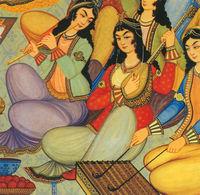 A more modest stringed instrument that is plucked vertically is the kamānĉē, which is four-stringed and also, like the previous one, fretless, to allow for the quarter tones widely used in Middle Eastern scales. Among the percussion instruments, small drums (kus) or cup-shaped ones (tombak) are used for recitals, while larger ones (naqqārē) are used in processional steps. At banquets and popular festivals, the strident double-reed trumpet known as surnā is an indispensable element. The reed flute of different lengths known as nei occupies a privileged place in Sufi music since it perfectly accompanies the recitation of ejaculations or mystical poems that allows the adepts to enter a trance.
A more modest stringed instrument that is plucked vertically is the kamānĉē, which is four-stringed and also, like the previous one, fretless, to allow for the quarter tones widely used in Middle Eastern scales. Among the percussion instruments, small drums (kus) or cup-shaped ones (tombak) are used for recitals, while larger ones (naqqārē) are used in processional steps. At banquets and popular festivals, the strident double-reed trumpet known as surnā is an indispensable element. The reed flute of different lengths known as nei occupies a privileged place in Sufi music since it perfectly accompanies the recitation of ejaculations or mystical poems that allows the adepts to enter a trance.
The Persian instrument par excellence in the repertoire of classical music (maqām) is the santur, a stringed instrument struck in a trapezoidal shape made of hazel or rosewood, depending on the desired sound, with seventy-two or ninety-six strings whose adjustable pegs are arranged in four series of eighteen strings, which pass over bridges attached to the soundboard. Using metal or wooden rods, the musician combines the low and middle registers on a scale of approximately three-eighths. In Europe, the dulcémele and the psaltery are some of the instruments used in medieval music derived from the Persian santūr.
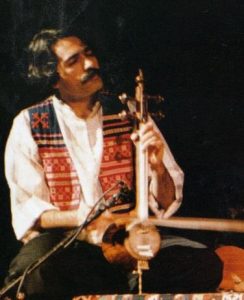 Images from the many musicological treatises written in the Arabic and Persian languages during the heyday of the Abbasid caliphate provide valuable insight into improvements and innovations in classical instruments, such as a low fifth string on the lute at the urging of the great musician Zaryāb. The miniatures and illustrations of the Persian historical chronicles also show the use of popular instruments such as castanets, tambourines, cymbals, trumpets and drums made of a wide variety of materials. The vast wealth of popular music in Iran has been the subject of numerous studies in the second half of the 20th century as tribes such as the Lor, Bajtiār, Qashqāi, Baluŷ or Kurds are the repositories of millenary musical repertoires that have undergone numerous influences and transformations throughout Iran’s history.
Images from the many musicological treatises written in the Arabic and Persian languages during the heyday of the Abbasid caliphate provide valuable insight into improvements and innovations in classical instruments, such as a low fifth string on the lute at the urging of the great musician Zaryāb. The miniatures and illustrations of the Persian historical chronicles also show the use of popular instruments such as castanets, tambourines, cymbals, trumpets and drums made of a wide variety of materials. The vast wealth of popular music in Iran has been the subject of numerous studies in the second half of the 20th century as tribes such as the Lor, Bajtiār, Qashqāi, Baluŷ or Kurds are the repositories of millenary musical repertoires that have undergone numerous influences and transformations throughout Iran’s history.
After the Constitutional Revolution of 1906 and, in particular, after the establishment of the Pehlevi dynasty, a process of systematization of the traditional repertoire of Persian classical music by masters such as Mohammed Reżā Šaŷariān, well known in Europe and the United States for his intense activity, he began as a soloist like Šahrām Nāzeri, one of the great interpreters of the mystical poems of Rumi or Mohammed Reżā Loṭfī teacher of the most recent generation of young musicians.
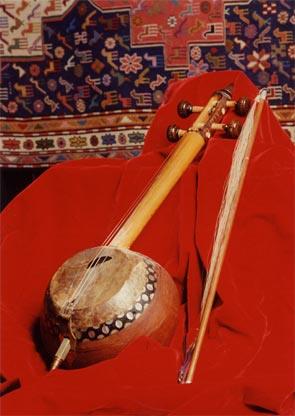
Kamānĉē 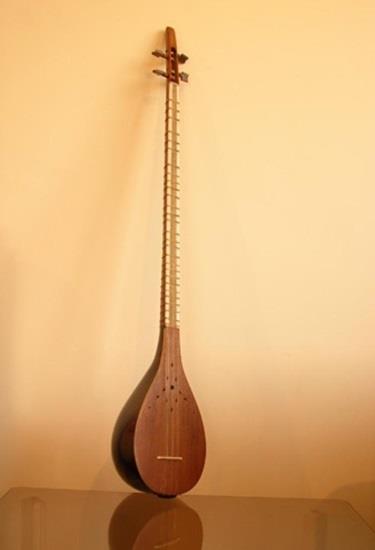
Setār 
Tombak 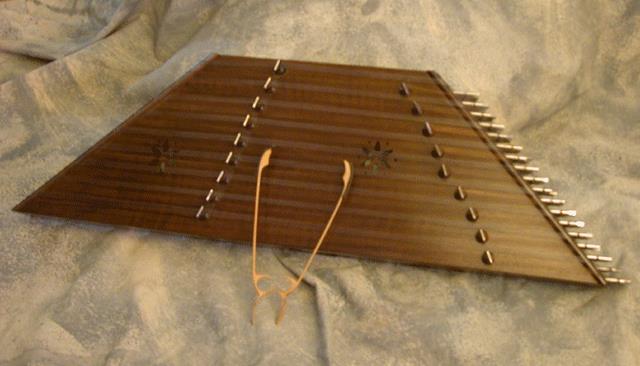
Santur 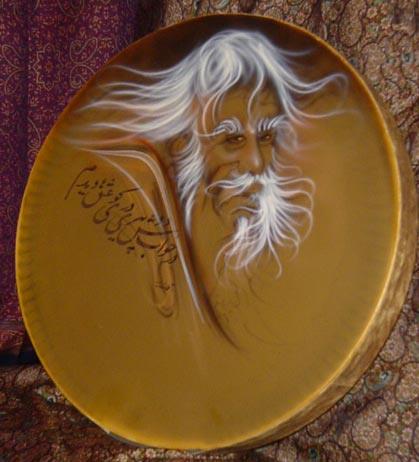
Daf 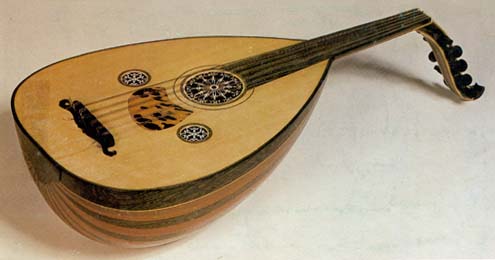
’Oud 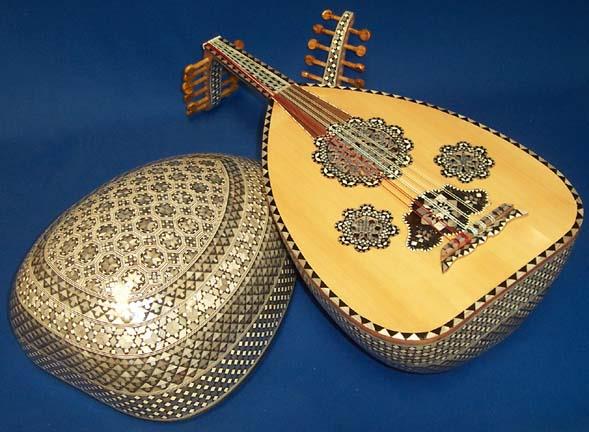
’Oud

